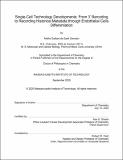Single-cell technology developments: from 3' barcoding to recording historical metadata through endothelial cells differentiation
Author(s)
Gaillard de Saint Germain, Alethe.
Download1227521521-MIT.pdf (33.29Mb)
Other Contributors
Massachusetts Institute of Technology. Department of Chemistry.
Advisor
Alex K. Shalek.
Terms of use
Metadata
Show full item recordAbstract
Complex organisms, such as humans and mice, consist of trillions of cells, yet we lack the tools to deeply characterize the immense space of cellular identity and behavior that defines health and disease. Indeed, evidence shows that cells, even those derived from identical clones, can present differences on the genomic, transcriptomic and epigenomic levels. It is therefore critical for researchers to be able to conduct studies at single-cell resolution in order to understand the vast diversity of life processes and further develop biological technologies. Here we describe the implementation of a plate-based 3' single-cell RNA-sequencing (scRNASeq) barcoding strategy which allowed us to dramatically reduce costs, ease implementation, improve throughput, and generate more quantitative data. Further developments in 3' barcoding strategies allowing parallel sequencing of thousands of cells at once, enabled us to study the mechanisms by which T cells cross into solid tumors, (i.e., their interactions with the endothelial cells lining blood vessels, and more specifically, venular endothelial cells; VEC). This revealed a unique transcriptional profile in VECs which highlights the importance of several transcription factors in establishing a gene signature conducive to T cell recruitment in immunogenic tumors. However, scRNA-Seq can only give us information about the state of a cell at the time of sequencing. Thus, to further explore the mechanisms at play behind single cell heterogeneity we worked on developing a strategy to record "historical" data in single cells. A CRISPR-based and a recombinase-based strategy were explored in this work. CRISPR presents the advantage of being very versatile and easy to multiplex, while recombinases are a well-established inducible DNA editing tool that is easier to implement. Using recombinases, we were able to demonstrate the recording of two independent signals in single cells. Overall, our work helped to establish 3' prime barcoding as a valid strategy for scRNA-Seq laying the foundation for the development of high throughput technology in the lab that we then used to explore endothelial cell responses in cancer and to develop of new tools to couple historical "metadata" with scRNA-Seq.
Description
Thesis: Ph. D., Massachusetts Institute of Technology, Department of Chemistry, September, 2020 Cataloged from student-submitted PDF of thesis. Includes bibliographical references.
Date issued
2020Department
Massachusetts Institute of Technology. Department of ChemistryPublisher
Massachusetts Institute of Technology
Keywords
Chemistry.